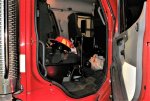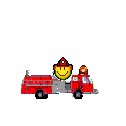That's a common item for the load management system - the AC is normally on a 60 amp circuit, and pulls about 45 amps when it's running (condenser and evaporator blower). Other things in the load management circuit often include an IV bag heater, and sometimes exterior flood lights.
One thing to remember is that the module (the ambulance portion) controls the entire heating/cooling system on a Medic Master, including the cab. If the module doesn't want heating or cooling, you will get very little from the Freightliner dash panels. About all the Freightliner panels will do is vary the cab blower speed, or adjust the cab temperature a little. The key is to set the module temperature fairly warm in cold weather (maybe 75F), and fairly cool in warm weather (maybe 65F). The cab can then do its own heating/cooling thing. I found this out when we brought mine back from PHL in May of 2014. We didn't have a lot of air conditioning, and no heating, because I didn't know that I needed to turn on the magic panel switch "Heat/Cool". When I found out how to use the system, I had it all -- heat, plus AC. If you have a walk through or a large window between the module & cab, leaving it open helps control the cab temperature a little.
Before you start chopping wires, maybe see why the battery voltage is low - it could be bad batteries, a poor connection, or a regulator problem. MNtal had alternator problems on his freightliner/Horton ambulance, but instead of spending many bucks on a new 270 amp alternator, he was able to get his rebuilt very reasonably. I'm guessing that you might have one bad diode in the rectifier portion - we ran into that a lot with M60 series tanks, and the maximum voltage we could get would be just over the 24 volt battery voltage instead of the 28 volts we wanted.
The second engine-mounted AC system is just for the module - if it goes away, the module can get hot while you're traveling, then the split system has to start with a high temperature. In my opinion, I'd keep it.









